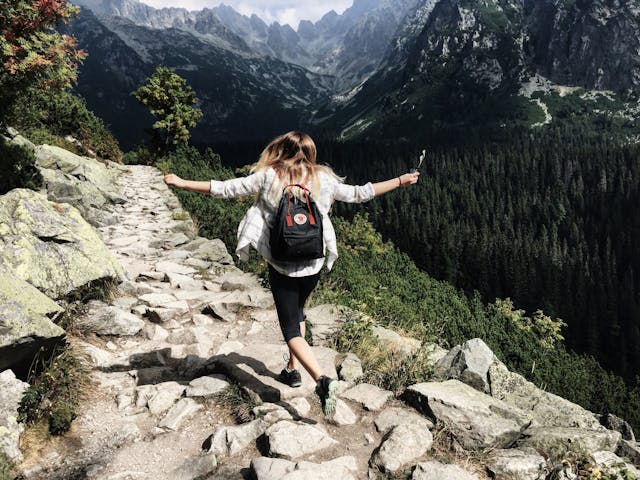
There is nothing like the rush of first setting out on a route. It’s the place where the peace of nature meets the excitement of exploration. On a hiking expedition, every step you take is a step out of the ordinary and into a world where the sound of rustling leaves and far-off birdsong sounds like a whispered invitation to explore further. Hiking’s real purpose is to enjoy the route as much as the goal, rather than just getting there.
Customized Layering: Dressing for All Weather Conditions
The cornerstone of a good hiking experience is appropriate clothing. Since the weather is unpredictable, you must dress with a plan, which means layering clothes is an essential part of your hiking equipment. Wearing layers makes it easy to adjust to shifting weather conditions and guarantees comfort whether it’s sweltering outside or a cold breeze comes up. Layering is all about being able to mix and match different pieces of clothing to create an ensemble that is both practical and adaptable. As it comes into direct touch with your skin, the base layer serves as your first line of protection. It is essential for controlling moisture as it draws sweat away from the body to keep you cool and comfortable. Choose materials that are known for their breathability and rapid drying, such as merino wool or premium synthetic textiles.
Optimal Footwear: The Pillar of a Comfortable Trek
Your feet carry you on every hike, so selecting the right shoes is one of the most important preparatory choices you will make. Hiking routes might take you on smooth, well-traveled roads or difficult, rocky inclines. The landscape can vary greatly. It’s critical for both comfort and safety to make sure your feet are properly supported and shielded. A good set of hiking boots or the best hiking shoes serves as the cornerstone of your journey, offering the support, traction, and cushioning you need to hike any path confidently. When choosing hiking shoes, consider the needs of your trek. Lightweight hiking shoes are comfortable and flexible, perfect for short, easy treks that need rapid, graceful movements. However, sturdy hiking boots are essential for more strenuous walks, particularly those that include rocky or uneven terrain.
Hydration Solutions: Staying Refreshed and Energized
Retaining sufficient fluids is essential for a good trek. Hiking’s physical strain and the environment’s combined effects may quickly drain your body’s water stores, leaving you tired and dehydrated. Maintaining a consistent hydration intake is important for maintaining energy levels and avoiding heat-related ailments in addition to slake thirst. Maintaining the right level of water helps your body function at its peak, which makes trekking less taxing and more pleasurable. It’s important to have enough water with you for the whole journey. While conventional water bottles are a dependable choice, hydration packs provide more convenience for trips of greater length. Because these packs include drinking tubes and reservoirs, you may drink from them hands-free, which promotes continuous hydration without stopping to get a bottle.
Nutritious Snacks: Fueling Your Journey
It’s important to maintain energy levels when hiking, which is why wholesome snacks are useful. Because hiking is physically demanding, you need to have sustenance on hand all the time to keep your body moving and your mind active. By bringing the appropriate food, you can guarantee that your energy levels remain constant, prevent exhaustion, and fully enjoy your journey. Keeping your body fuelled and satiated requires choosing snacks that provide a combination of carbs, proteins, and fats. Your body uses carbohydrates as its main energy source, particularly when engaging in extended physical activity. The energy that is quickly and readily absorbed is provided by snacks like granola bars, dried fruit, and whole grain crackers, which may help you maintain your energy level and endurance. Nuts, seeds, and jerky all provide proteins, which are vital for muscle growth and repair and for sustaining your body throughout the strenuous physical activity of hiking.
Emergency Essentials: Be Prepared for the Unexpected
It is impossible to control nature completely, no matter how well-planned your trek is, so having emergency supplies on hand is an essential part of hiking safety. Having a fully stocked emergency kit with you guarantees that you are prepared for everything from small wounds to abrupt weather shifts. This planning gives you peace of mind and protects your health so you can concentrate on enjoying your journey. First aid materials for common injuries, including cuts, scrapes, and blisters, such as bandages, antiseptic wipes, and painkillers, should be included in a full emergency kit. Think about including goods unique to hiking locations in addition to these essentials, including tweezers for extracting ticks or splinters, a small multi-tool for several purposes, and moleskin for preventing blisters.
Conclusion
The cornerstones of a good hiking trip are comfort, safety, and planning. Every component is essential to making each trek an enjoyable and unforgettable adventure and to augmenting your overall experience. Accept these necessities and enter the world of trekking with joy and confidence, eager to discover and appreciate the splendor of the natural environment.


